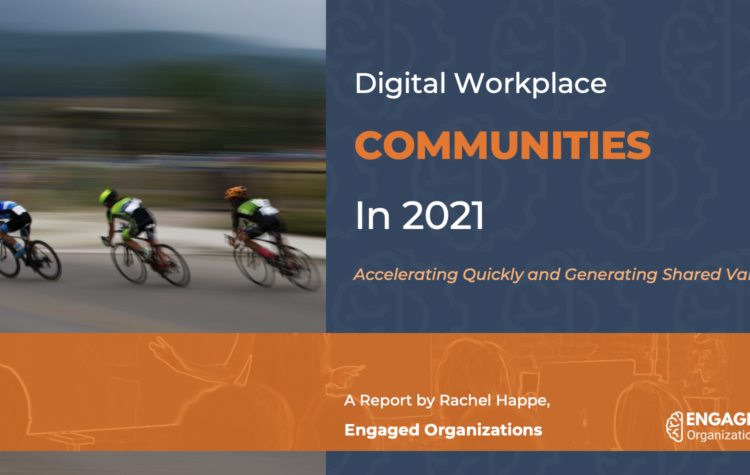Now available – new research on Enterprise community programs, how they operate, and what impact they have.
Digital Workplace Communities in 2021 offers data about the changing visibility and impact of these programs, especially as organizations adjusted to the COVID pandemic and now as they navigate a hybrid workplace. The results are remarkable. Those organizations with enterprise community teams are seeing them successfully address some of the most vexing organizational challenges.
Community Management is the Future of All Management
I believe that how organizations manage and operate needs to change in fundamental ways.
As technology has evolved, it has taken over much of the standardized work that humans used to do. In many ways, this is great because standardized production work is often drudgery combined with pressure. It does not spark joy even when it is tolerable. As humans do less production, work shifts to ambiguous tasks that rely on creativity and collaboration to create new or unique solutions based on a complex contextual factors.
People, however, cannot be managed or coerced into more creativity and collaboration. Creativity and collaboration is sparked and developed by social conditions that inspire and reward it. Working harder won’t increase or improve creativity – in fact, creativity and collaboration usually come from trying less and playing more. That is anathema to most people’s employment experience.
When I started The Community Roundtable in 2009, I had a hypothesis that community managers held the key to the future of management and organizational governance. Community managers have no ability to tell community members what to do – because members are not contractually bound to the community and or paid to be there – engagement is entirely optional. Yet online communities were demonstrating that significant value could be created without exerting control over people. The platform I am writing this on, WordPress, runs almost 40% of the ALL websites – and it is easier to use than any enterprise software I have experienced. Not only is it open source but it enables a community of developers to create thriving businesses in its ecosystem. It is not only powerful software – it is a powerful business model. It is hard to beat as a competitor. Clearly, there was something I could learn from online communities. Today we can identify and articulate the operational patterns of thriving communities. My hypothesis was correct; communities, and the people who manage them, have developed a powerful model from which all organizations can learn. Indeed, organizations must if they hope to survive.
Lessons from Community Managers
In the past decade, community management has become a much more understood and documented discipline. It is a cross-disciplinary approach that integrates social, communications, technical, business, strategic, and leadership skills. Far from being the people who tweet, it requires a much more complex set of skills and no one can do it well on their own.
Community professionals manage the system, not individuals and develop the governance, which fosters constructive cultures. By understanding how behavior is influenced, they optimize environments to encourage and reward specific behaviors. This requires an interplay between infrastructure, social influence, governance, faciliation, and programming.
Community management is very different approach than what we currently think of as management. It is a discipline that is practiced and done well by the best teachers, event planners, parents, executives, mayors, and ministers. In many cases it is more intuitive than explicit. The skills exist in the world, but are not often explicitly taught, cultivated, and rewarded especially not in many organizations. It’s time to change.
Enterprise Community Programs Demonstrate Compelling Success
 COVID has been a great change agent. It opened executives’ eyes to what was already happening but had gone unseen or unacknowledged; that work was no longer working for many employees. Already straining under the weight of increasingly broken work environments, the pandemic triggered a great reevaluation of priorities. For many working parents, especially mothers, the pandemic was the stick that broke their back.
COVID has been a great change agent. It opened executives’ eyes to what was already happening but had gone unseen or unacknowledged; that work was no longer working for many employees. Already straining under the weight of increasingly broken work environments, the pandemic triggered a great reevaluation of priorities. For many working parents, especially mothers, the pandemic was the stick that broke their back.
Clearly, something fundamental needs to change. Work needs to work better for people. One of the major needs is flexibility, including not only how much people work but how they work. People want more self-determination – and they need it to be healthy, engaged, and energetic. That sounds an awful lot like what community models can provide.
This year’s research shows that existing enterprise community programs generated compelling value for both their organizations and its employees. This shared value increased innovation end efficiency for the organization while giving employees easier ways of working and support for their growth and empowerment. 58% of community programs could directly connect their impact to increasing employee trust in the organization.
What executive wouldn’t want that?




